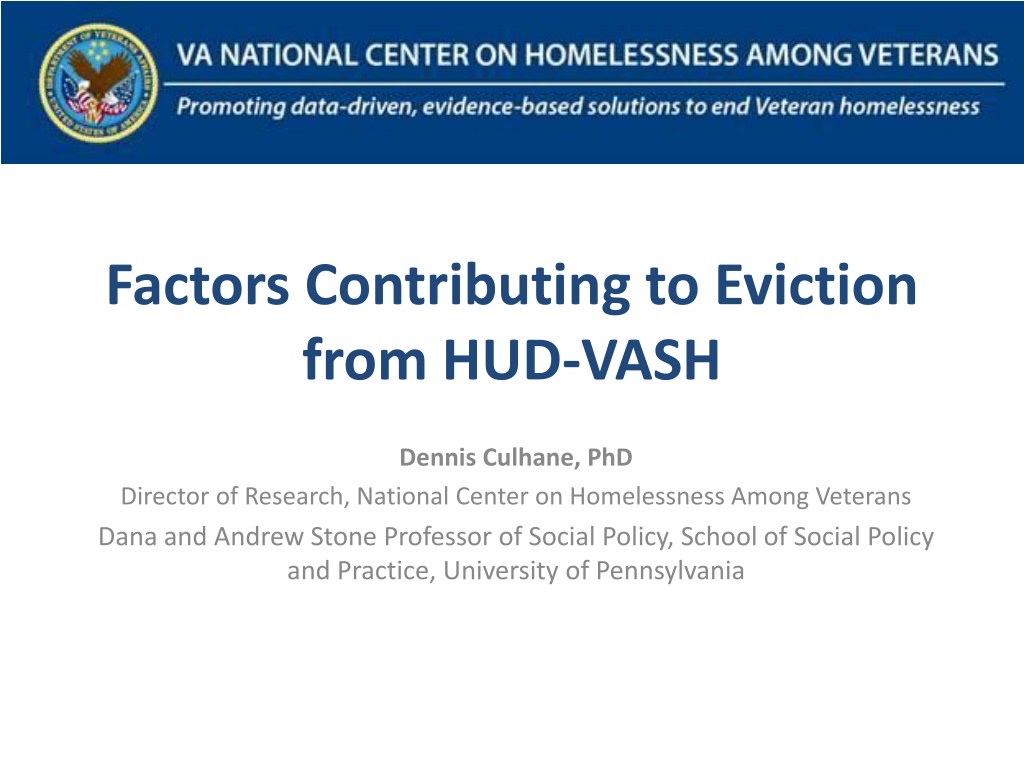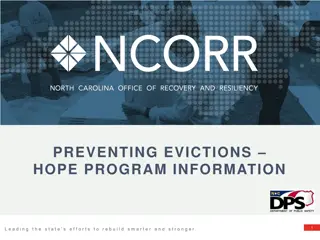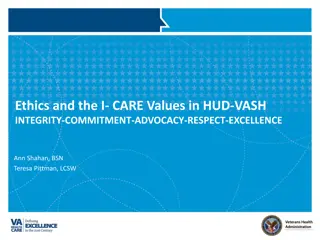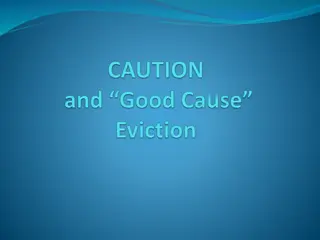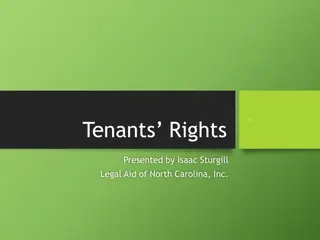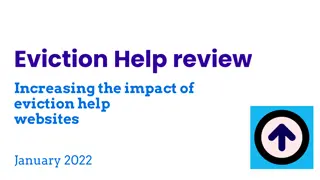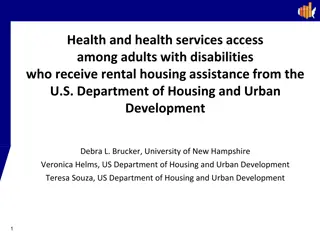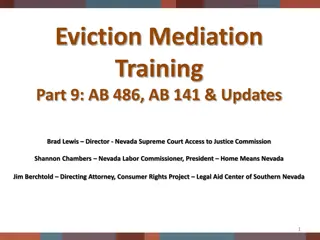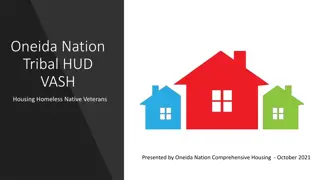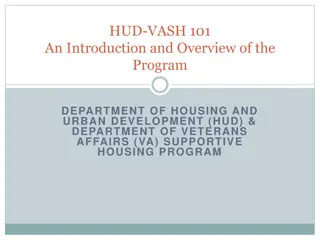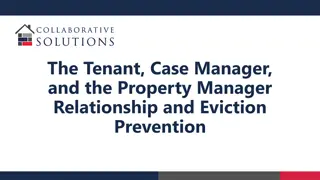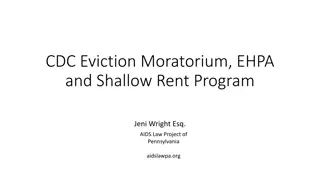Factors Leading to HUD-VASH Eviction
Factors contributing to eviction from HUD-VASH, exits from permanent supportive housing, study objectives, methods, and analysis on potential correlates and precipitating events. Focus on identifying eviction signals and assessing utility of real-time data for service providers.
Download Presentation

Please find below an Image/Link to download the presentation.
The content on the website is provided AS IS for your information and personal use only. It may not be sold, licensed, or shared on other websites without obtaining consent from the author.If you encounter any issues during the download, it is possible that the publisher has removed the file from their server.
You are allowed to download the files provided on this website for personal or commercial use, subject to the condition that they are used lawfully. All files are the property of their respective owners.
The content on the website is provided AS IS for your information and personal use only. It may not be sold, licensed, or shared on other websites without obtaining consent from the author.
E N D
Presentation Transcript
Factors Contributing to Eviction from HUD-VASH Dennis Culhane, PhD Director of Research, National Center on Homelessness Among Veterans Dana and Andrew Stone Professor of Social Policy, School of Social Policy and Practice, University of Pennsylvania
Exits from Permanent Supportive Housing High rate of housing retention in PSH, but exits may be associated with a number of factors Nonpayment of rent1 Use of emergency services2 Substance abuse3 5 About 1 in 10 Veterans leave HUD-VASH due to eviction, which is associated with negative consequences Ongoing residential instability6 Relocation to neighborhoods with higher poverty and crime7 Relocation to substandard, lower-quality housing, which may directly impact health8 10 Material hardship11 Homelessness4,11,12
Study Objectives To identify correlates of eviction both tenant characteristics and precipitating events that may signal imminent eviction To assess potential utility of a real-time, data- driven system of notification for services providers
Methods Potential Correlates Veterans characteristics Tenure in HUD-VASH housing Sex Age Military experience Service-connected disability Medical, mental, and behavioral health diagnoses Sample & Analysis Sample: 20,146 Veterans who exited HUD-VASH (10/2008 2/2016) Evicted Accomplished goals Analysis: logistic regressions controlling for demographics, diagnoses with 3 patterns of precipitating events/services use Precipitating events Inpatient admissions Emergency Department (ED) visits Outpatient care
Precipitating Events Services Use Model Eviction Used inpatient, ED, outpatient care Used inpatient, ED, outpatient care Used inpatient, ED, outpatient care Increased Services Use Model Eviction Increased use of inpatient, ED, outpatient care Acute Care Use Model Eviction 1 inpatient admission or 2 ED visits 1 inpatient admission or 2 ED visits 1 inpatient admission or 2 ED visits Inpatient and ED care categorized as medical, mental health, substance use; outpatient care categorized as primary care, medical, mental health, substance use, HUD-VASH case management; acute care includes any type of inpatient or ED service
Veterans Characteristics Evicted (n=4,684) Accomplished Goals (n=15,462) Characteristics p Length of residence (months) 19.2 27.2 <.001 Female (%) 9.1 14.5 <.001 Age (%) <.001 < 35 11.3 10.6 35 54 43.4 39.2 55+ 45.4 50.3 Combat exposure (%) 4.7 5.5 .011 Service-connected disability (%) 41.4 46.8 <.001 Diagnoses (%) Chronic medical condition 36.2 31.5 <.001 Depression 43.2 36.1 <.001 PTSD 18.0 15.6 <.001 Psychosis 9.5 4.8 <.001 Suicide/self-harm 10.7 1.5 <.001 Alcohol use disorder 32.5 11.2 <.001 Drug use disorder 38.6 12.2 <.001
Services Use 90 Days Prior to Exit Inpatient Admissions Emergency Department Visits 7.1% 20.3% 5.0% 4.3% 10.9% 7.2% 5.7% 1.7% 0.4% 0.3% 0.6% 0.2% Medical SMI SUD Medical SMI SUD Acute Care Use 10.9% 7.3% 6.4% 1.5% 1.4% 1.3% 61-90 31-60 0-30 Days Prior to Exiting HUD-VASH
Veterans Characteristics Eviction Decreased Odds of Eviction Increased Odds of Eviction Younger age (<65) Longer tenure in HUD-VASH 1.22 1.27 Psychosis 0.96 PTSD Chronic medical condition Male sex 1.48 - 1.49 Service-connected disability Alcohol use disorder 0.85 0.88 Suicide/self-harm 1.46 - 1.52 Drug use disorder 1.65 1.72 0.72 0.87 1.56 2.10 0.67 0.72 2.54 2.69
Services Use Model 0.64 HUD-VASH 1.44 1.49 0 30 days prior to exit Outpatient SUD 61 90 days prior to exit 0.72 1.03 SMI 0.85 0.77 Medical 0.74 0.93 Primary care 0.82 Emergency 4.79 SUD 4.10 3.51 SMI 2.65 2.03 Medical 1.45 6.85 SUD Inpatient 2.06 3.26 SMI 2.30 1.59 Medical 1.85
Increased Services Use Model HUD-VASH 0.83 Outpatient SUD 1.71 SMI 1.23 Medical 0.75 Primary care 0.95 Emergency SUD 6.25 SMI 3.72 Medical 2.00 SUD 7.98 Inpatient SMI 3.05 Medical 1.65
Acute Care Use Model 4.67 2.36 2.34 61 90 days prior to exit 31 60 days prior to exit 0 30 days prior to exit
Precipitating Events Eviction Any inpatient admission or ED visit, particularly related to substance use Acute care Outpatient care related to substance use Increased odds of eviction (Best predictors: increases in use over time and use 30 days prior to exit) Decreased odds of eviction Primary care and medical outpatient care HUD-VASH case management (Best predictors: increases in use over time and use 30 days prior to exit)
Potential Utility of Predictive Model Veterans characteristics and precipitating events (patterns of acute health services use) are related to increased likelihood of eviction In each model, the use of specific types of acute care within 30 days of exit are the best predictors Allows little time to intervene but may serve as an efficient, and hopefully effective, warning flag Other variables (e.g., nonpayment of rent) may also predict eviction, but are not readily available
For More Information Montgomery, A. E., Cusack, M. C., Szymkowiak, D., Fargo, J. D., & O Toole, T. P. (2017). Factors contributing to eviction from permanent supportive housing: Lessons from HUD-VASH. Evaluation and Program Planning, 61, 55 63. doi:10.1016/j.evalprogplan.2016.11.014 http://www.sciencedirect.com/science/article/pii/S0149718916301379
References 1. Bernet, A., Warren, C., & Adams, S. (2015). Using a community-based participatory research approach to evaluate resident predictors of involuntary exit from permanent supportive housing. Evaluation and Program Planning, 49, 63 69. Crane, M., & Warnes, A. M. (2000). Evictions and prolonged homelessness. Housing Studies, 15(5), 757 773. Lee, S., Wong, Y-L I., & Rothbard, A. B. (2009). Factors associated with departure from supported independent living programs for persons with serious mental illness. Psychiatric Services, 60(3), 367 373. Mojtabai, R. (2005). Perceived reasons for loss of housing and continued homelessness among homeless persons with mental illness. Psychiatric Services, 56(2), 172 178. Wong, Y-L I., Poulin, S. R., Lee, S., Davis, M. R., & Hadley, T. R. (2008). Tracking residential outcomes of supported independent living programs for persons with serious mental illness. Evaluation and Program Planning, 31, 416 426. Desmond, M. (2015). Unaffordable America: Poverty, housing, and eviction. Fast Focus, No. 22-2015. Retrieved from http://www.irp.wisc.edu/publications/fastfocus/pdfs/FF22-2015.pdf Desmond, M., & Shollenberger, T. (2015). Forced displacement from rental housing: Prevalence and neighborhood consequences. Demography, 52, 1751 1772. Desmond, M., Gershenson, C., & Kiviat, B. (2015). Forced mobility and residential instability among urban renters. Social Service Review. Desmond, M. (2012). Eviction and the reproduction of urban poverty. American Journal of Sociology, 118(1), 88 133. Desmond, M., & Kimbro, R. T. (2015). Eviction s fallout: Housing, hardship, and health. Social Forces, sov044. Burt, M. (2001). Homeless families, singles, and others: Findings from the 1996 National Survey of Homeless Assistance Providers and Clients. Housing Policy Debate, 12, 737 780. Stefancic, A., & Tsemberis, S. (2007). Housing First for long-term shelter dwellers with psychiatric disabilities in a suburban county: A four-year study of housing access and retention. The Journal of Primary Prevention, 28(3-4), 265 279. 2. 3. 4. 5. 6. 7. 8. 9. 10. 11. 12.
